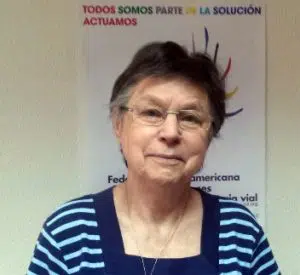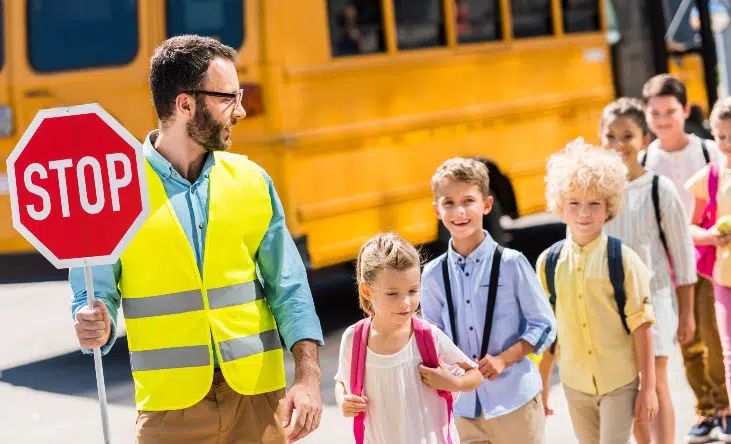SUSTAINABILITY| 17.11.2021
Jeanne Picard (FICVI): “When we are behind the wheel, we are least aware of the risk, until something bad happens”
Every year, 1.3 million people die in traffic accidents. This is an unacceptable figure that the UN wants to reduce by half in a decade as part of the new Global Plan for the Decade of Action for Road Safety. We spoke to the Chairwomen of the Ibero-American Federation of Victims Associations Against Road Violence(FICVI) and co-founder of STOP Accidentes in Spain, Jeanne Picard, to discuss the achievements and challenges we face in the fight against road violence, particularly targeting Latin America and developing countries and the most vulnerable groups: pedestrians, children, cyclists and motorcycle riders. The organization, which collaborates directly with Fundación MAPFRE on road safety issues and the prevention of road accidents, is celebrating their inclusion in the SDGs and calls for a greater political will to avoid the most dangerous cars or those driven with no respect for life as “coffins on wheels”.
 The UN’s new Global Plan calls on countries to make a greater commitment, including signing up to international conventions on vehicle safety. Manufacturers are being asked to bring their security devices up to standard. What is the situation in the most impoverished nations, with the worst roads?
The UN’s new Global Plan calls on countries to make a greater commitment, including signing up to international conventions on vehicle safety. Manufacturers are being asked to bring their security devices up to standard. What is the situation in the most impoverished nations, with the worst roads?
The most dangerous cars are sold in countries in which safety is lacking most, in Latin America. It’s scandalous. In Europe, we increasingly have more advanced driver-assistance systems (ADAS) and, in general, safer cars. However, we are selling the most dangerous cars to less developed countries, which have lower purchasing power. Why? Because all these safety measures and devices come at a cost. And so they are eliminated to lower costs and sell more. And in Latin America and the Caribbean there is a huge second-hand and even third-hand car market. In Guatemala, there are vehicle graveyards, many sent from the United States, where nobody wants them anymore on account of how unsafe they are, where they are resold. One thing is certain, safety comes at a price. But it should be the same for everybody: we cannot manufacture safe cars in Europe and sell more dangerous cars in Latin America. No matter how safe a driver you are, if the car isn’t safe, the consequences of an accident are going to be worse.
What conclusion was reached regarding the 1st Global Plan, and what is the emphasis of the new plan for the decade of 2021-2030?
The conclusion as regards the first plan, which was a source of hope when it was conceived, was pretty disappointing. Unfortunately, fatal accidents and even serious injuries remain on the rise. We have achieved something though: for example, Argentina and Colombia now have national road safety agencies, which have a dedicated budget, and Chile is making major legislative efforts. However, there are other countries that are much more dangerous. Everything depends on political will.
The new Global Plan for the Decade of Action for Road Safety 2021-2030 offers us new hope. At least now, road safety and reducing accidents are included among the Sustainable Development Goals (SDG). You have you admit that the SDGs are well thought out, very ambitious and really well explained. They are an excellent initiative at a global level. However, they are not binding: they are goals. That means that the commitment to them remains undefined, which we are currently seeing in the case of climate change. No matter how many documents we sign and how much we want to achieve them, if we don’t meet them… The SDGs encompass education, justice and civil society. That gives us a platform, which is really important. I really do hope that this time, countries meet them.
The UN named road safety a Public Health problem in 2004. In 2021, it is still insisting that countries recognize it as such and that mobility is a fundamental human right and a social common good. What role should legislation and international conventions play in achieving this real progress?
It definitely provides the foundation. If we do not have or achieve legislation that fits the goals, we’re not going to achieve anything. Legislation is essential. For example, in Mexico, there is currently no road safety law. This is an enormous country, where 400 people die on the roads every day! I think they are working on it and, thankfully, civil society is really mobilized in this area. They have had to change the Constitution. This is all a very slow process, but it is true that progress is being made. We hope Mexico will have legislation in this field in the coming ten years. The sooner, the better. This is just one example that, without laws, we are obviously not going to make progress. And then, the law has to be enforced. Many countries have a law in place, but fail to enforce it. If there is no oversight of the law, people will continue to break it, not to mention the problem of corruption. In fact, the new Global Plan also addresses that…
I know that efforts are being made, and I always try to remain positive: I’ve had to learn to be patient. But I would like to emphasize that changing laws is so important, not only road safety laws, but victim protection laws too. Justice has to be preventive for society, it has to educate offenders and protect victims. I don’t call this consolation, as there is no consolation for somebody who has lost a loved one on the road. We don’t want a payout to compensate the lives of our loved ones. Our children are priceless. Having said that, prevention is what we need.
One of the issues you insist on is responsible driving. What type of conduct can we expect from a responsible driver and what role do organizations like Fundación MAPFRE or FCI play in promoting road safety and raising awareness about risks?
Organizations like Fundación MAPFRE, which we have collaborated with since our foundation in 2010, play a critical role. When it comes to education, they play a huge role, not just in terms of information, but in training. Education, along with justice and health, are the basis of democracy. However, education is very slow. We are now working with a generation that, we all hope, will be the generation of responsible drivers. Educating people over the age of 40 or 50 who did not receive this education, raising awareness, changing attitudes and behaviors is very difficult. Bad habits are easy to acquire, but changing them is more difficult, as is the case in all areas of life. Education, training and, most importantly, information is what we need. We have seen this in Spain, when the points-based driving license was introduced. Sometimes, sanctions are part of the education process. Being docked points on your license makes you think. Drivers are still not being educated in Latin America, because many people simply buy their driver’s license. How many? That’s the million-dollar question. It is easier to buy your license than go to a driving school and actually learn; most importantly, learning to be aware of the risk. I think that mobility is where we are least aware of the risk posed until something bad actually happens. We have to be aware before the worst happens, because we have in our hands a machine that is capable of killing people. Nobody starts their vehicle thinking that they might have an accident, but then added to that, we are not aware of the risks: speed, alcohol, distractions, etc.

Tremendous risks, such as in the vicinity of schools.
That’s right, Fundación MAPFRE has been performing in-depth analyses of school environments and generating studies for some time now. We are starting to collaborate closely with Mexican associations. There is an association in Mexico that wants to become more active and we are doing everything we can to help. Back in Spain, in A Coruña, we are also hard at work. What has happened here in Madrid, the uproar generated by the accident at the entrance to a school in Mirasierra, has sounded alarm bells, but we keep saying: this is our daily battle with parents. Conduct, personal responsibility, but also, as indicated in the Safe System in the Global Plan, it is so important to take care of infrastructures and traffic management and organization systems. We cannot allow people to park haphazardly outside schools. We need to walk to pick up our children. And if there is no alternative to going by car, then we need safe parking, where cars can be parked and children can be accompanied to the school gates on foot. This chaos we are seeing in many schools is unacceptable, especially when school transportation is available. Either all children should be traveling by bus or we will need to look for infrastructure solutions. This is a responsibility that is shared by town halls, schools and parents. Children must be safe both at school and when they leave school. We have to stop this chaos, even though mom and dad might be in a hurry. All cities have understood that something needs to be done. It’s sad that this is always an afterthought.
In Latin America, we are working on this as transportation really is a problem. Sometimes, children walk along the side of the road with no safety at all, for two or three kilometers, until they get to school. Their school environments are not safe at all and, as a result, getting there isn’t either. It is a serious problem that requires our attention. Sometimes, adults travel without a helmet with two or three children on a motorcycle. Steps are being taken, but it is cheaper to buy a motorcycle that comes from China in a box, disassembled as if it were a piece of furniture, than it is to pay for a monthly public transport pass. You have to assemble them yourself, and if you make even the slightest mistake, in a matter of days the brakes are failing, etc. Some are so cheap that if you are fined by the police, it is cheaper just to buy another than pay the fine. It is the same case as with cars: cheap motorcycles and a complete lack of safety. Cyclists, who are not as prevalent in cities, are also more vulnerable. We have to protect these groups: pedestrians, cyclists, motorcycle riders.
The comprehensive approach of this new global plan is eye-catching, not only because of the connection to the SDGs you have mentioned, but also in terms of safe systems, the inclusion of gender issues, etc. What are the main challenges this new approach poses?
The challenge is actually following through. There are a lot of commitments we need to deliver on. They are very well explained and the fact that gender is addressed is great, given that women are the better drivers, and it is good that this has been recognized. However, there are as many challenges as there are goals. They are saying that we have to reduce mortality by 50% worldwide. If only. That is going to be difficult, not so much in developed countries, where we might be able to do it, but more so in developing countries: if we don’t help economically and socially, it is going to be impossible. Some years ago, Spain was 50 years behind our Nordic neighbors, when in 2004, Pere Navarro, during his first stint as director general of Traffic, made it very clear that we had to import the models used by countries that were doing a good job. This improved Spain’s performance. What is happening in Latin America? I always say the same: Copy Europe, don’t keep doing things that we already know don’t work. Helmets save lives, seat belts do too… But the law there doesn’t help. Because people are not required to wear a seat belt in some countries, manufacturers don’t install them. It is a huge challenge that really depends on political will, on leaders taking measures and lawmakers, Congress and the Senate, making road safety a priority, given that it is a huge public health and economic problem. The model is explained well in the Safe System. Why not implement it? Because there is a lack of political will. Civil society providing a united front and making the voice of victims heard, our work, has been a step forward. In Argentina, we did it; in Colombia, Chile, Costa Rica… In Mexico, civil society is really enthusiastic about it, and that is pushing us forward. Making victims of road violence a political priority is the first step toward saving lives.

